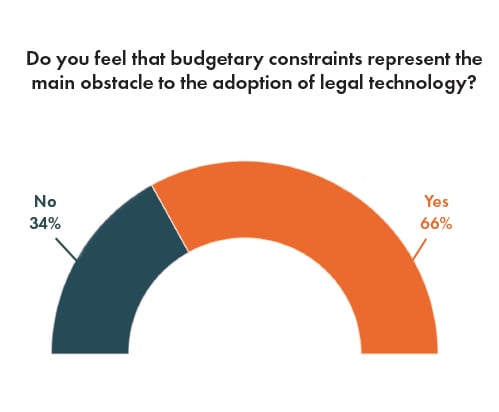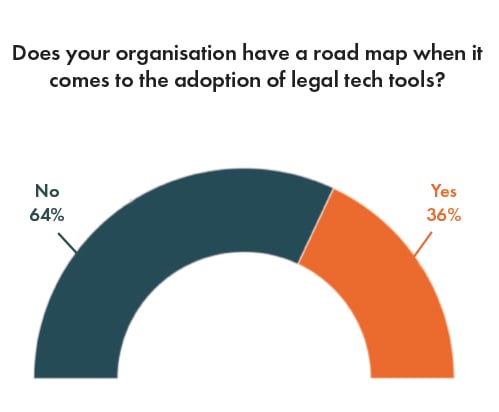A two thirds majority consider budgetary constraints as the main challenge to implementing legal technology. However, when digging into additional responses by GCs that answered ‘No’, a more detailed picture emerges, especially as it relates to budgetary constraints and broader corporate culture, the importance of in-house legal teams in the eyes of corporate leadership, and difficulties in communicating the importance of legal tech in response to changing pressures and workloads on in-house legal teams.
Many respondents expressed, as previously mentioned, a feeling that they were caught in the paradox of choice. With, at some times, substantial upfront costs and long-term investment, as one GC noted, ‘tech implementations are complicated and require a lot of support and time to make it successful.’ Other respondents expressed frustration that there was ‘no time and expertise to dive into the topic and set up a project – we’re still operating under the attitude that old solutions will solve everything into looking into new processes first.’
When faced with too many options and too high a cost to implement, some may avoid implementing legal tech until the market becomes consolidated. Some even expressed ignorance of where things currently stood. One GC even said their biggest obstacle was their general lack of knowledge about the available tools at their disposal. For many lawyers, legal tech can feel overwhelming, especially for older GCs that are often disparaged online as the ‘how do I open pdf?’ generation. But legal tech continues to advance at a rapid pace, and even younger generations of lawyers know the experience of stepping away from software for a short period of time to return to an updated UI that looks entirely alien to them.
Other respondents noted a ‘resistance to change on the part of employees’, corporate ‘culture’, or ‘inertia’ in ways of thinking. This conservative attitude towards change may be due to any number of factors, including the adage, ‘if it ain’t broke, don’t fix it’, expressed in one response that noted they were operating in a culture that was fixed in ‘the old way of doing things’. This, however, is diametrically opposed to the fact that changes in the amount and extensions of the type of work done by in-house counsel practically demand they have access to the best available tools to properly do their job. This failure to secure ‘organisational buy-in’ was by far the second highest stumbling block to in-house counsel securing funding to access new legal tech.
Another GC expressed this difficulty in demonstrating the importance of adopting legal tech as follows: ‘legal tech requires a lot of work to convince others it is worth the cost, while some more traditional costs are accepted more easily by our organisation.’ Similarly, another GC commented, ‘other client-serving lines are more important than our in-house legal department’, while another lamented ‘value of legal tech is not perceived with the financial decision-makers.’ Generally, in these instances, the biggest hurdle was the perception of cost by leadership, especially if a particular programme or application could not be used universally, even if procuring it was desirable.
One GC’s comments provide a synthesis of the other major hurdles facing GCs wishing to implement legal tech: ‘Overall the biggest difficulty is navigating in an IT world where we have little knowledge, little insight and do not speak the same language. It has been critical to find the right partners in IT who can translate our visions into reality. We pride ourselves on being persuaders, but we needed allies to achieve anything.’
A small number note that there were conflicts between in-house IT security measures and the legal tech available to them, with providers not matching their security standards, or noted that ‘contractual relationships’ already in place made it difficult to implement any automation tools or legal tech generally. Others felt that integration of legal tech with existing platforms or systems was the biggest stumbling block to introducing new legal tech into in-house legal teams.
And in rare cases, respondents felt ‘most existing tools are useless’ or felt the ‘mindsets of our in-house lawyers’ prevented them from implementing legal tech. These responses noted that other lawyers on their team felt more secure using ‘paper-based processes’ or could not set down a clear measure on return of investment in new legal tech. In these cases, some GCs pleaded for buy-in on their teams. As one GC said, ‘there is a need for a paradigm shift. Not many people see the benefits of automated legal tech.’
Given companies’ increased interest in legal tech, we have asked our respondents if their companies have clear road maps regarding legal tools.
While the minority, 36%, answered yes, 64% of the respondents affirmed that their corporations do not have a clear plan to adopt the legal tech. As one GC noted, ‘budgetary constraints and other more pressing matters redirect the focus of the team’s attention.’ The main reason behind that seems to primarily a limited budget and small team size; however, increased pressure on legal teams regarding compliance involving sustainability and additional disclosure on ESG also were brought up as limiting the time available for legal teams to construct and adhere to a road map.
There is also a significant number of GC that suggest that even if the time and funding were available, it was simply impracticable for the time being to draft a road map regarding legal technology, mainly because the legal tech space is evolving so fast for that it proved too difficult for the team to establish a medium/long-term plan.
Furthermore, a majority of the respondents state that even though they were interested in implementing legal tech, their companies did not have buy-in regarding the efficiency of legal tech, in part because the corporate side felt the benefits were too hard to measure and they could not see any obvious positive externalities that would be seen outside the legal team.


